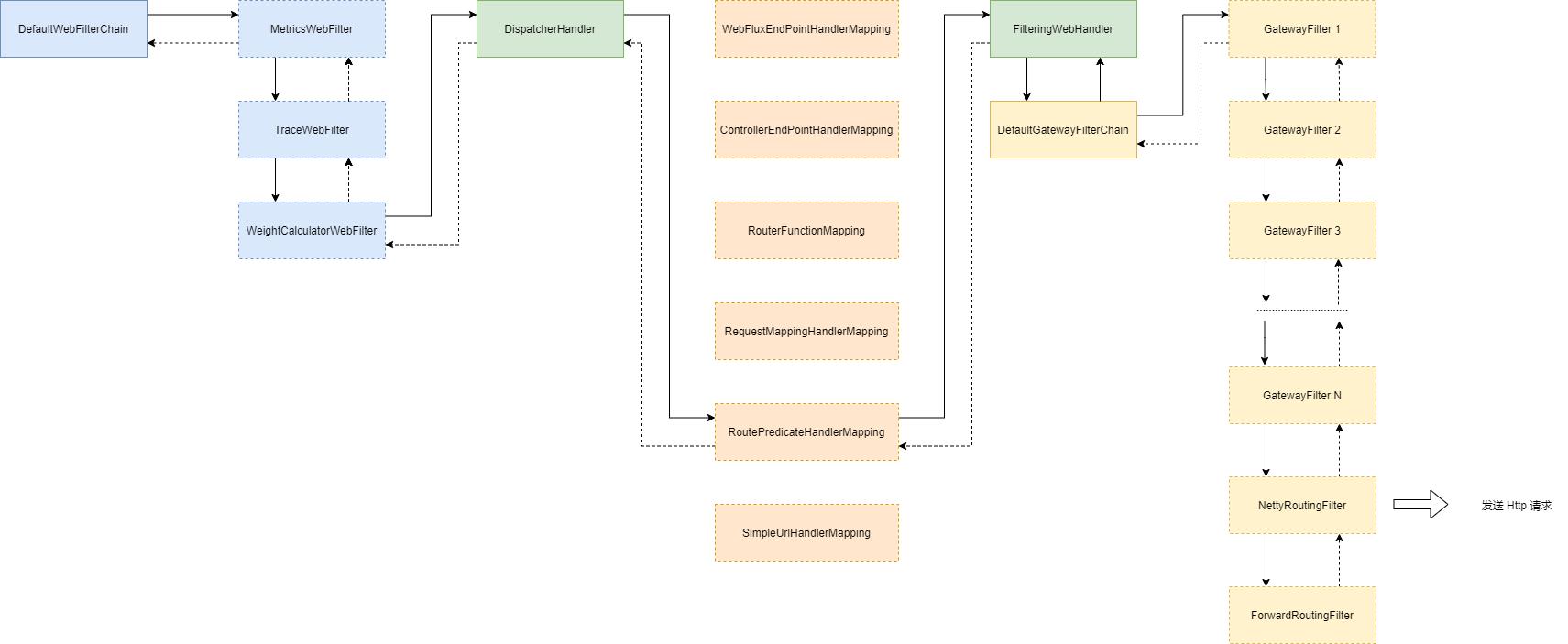Spring Cloud Gateway 没有链路信息,我 TM 人傻了(上)
Posted 干货满满张哈希
tags:
篇首语:本文由小常识网(cha138.com)小编为大家整理,主要介绍了Spring Cloud Gateway 没有链路信息,我 TM 人傻了(上)相关的知识,希望对你有一定的参考价值。
本系列是 我TM人傻了 系列第五期[捂脸],往期精彩回顾:

本篇文章涉及底层设计以及原理,以及问题定位和可能的问题点,非常深入,篇幅较长,所以拆分成上中下三篇:
- 上:问题简单描述以及 Spring Cloud Gateway 基本结构和流程以及底层原理
- 中:Spring Cloud Sleuth 如何在 Spring Cloud Gateway 加入的链路追踪以及为何会出现这个问题
- 下:现有 Spring Cloud Sleuth 的非侵入设计带来的性能问题,其他可能的问题点,以及如何解决
我们的网关使用的是 Spring Cloud Gateway,并且加入了 spring-cloud-sleuth 的依赖,用于链路追踪。并且通过 log4j2 的配置,将链路信息输出到日志中,相关的占位符是:
%X{traceId},%X{spanId}
但是最近发现,日志中链路信息出现丢失的情况,这是怎么回事呢?
Spring Cloud Gateway 的基本流程与实现
首先简单介绍一下 Spring Cloud Gateway 的基本结构,以及 Spring Cloud Sleuth 是如何在其中嵌入链路追踪相关代码的。加入 Spring Cloud Sleuth 以及 Prometheus 相关依赖之后, Spring Cloud Gateway 的处理流程如下所示:

Spring Cloud Gateway 是基于 Spring WebFlux 开发的异步响应式网关,异步响应式代码比较难以理解和阅读,我这里给大家分享一种方法去理解,通过这个流程来理解 Spring Cloud Gateway 的工作流程以及底层原理。其实可以理解为,上图这个流程,就是拼出来一个完整的 Mono(或者 Flux)流,最后 subscribe 执行。
当收到一个请求的时候,会经过 org.springframework.web.server.handler.DefaultWebFilterChain,这是 WebFilter 的调用链,这个链路包括三个 WebFilter:
org.springframework.boot.actuate.metrics.web.reactive.server.MetricsWebFilter:添加 Prometheus 相关依赖之后,会有这个 MetricsWebFilter,用于记录请求处理耗时,采集相关指标。org.springframework.cloud.sleuth.instrument.web.TraceWebFilter:添加 Spring Cloud Sleuth 相关依赖之后,会有这个 TraceWebFilter。org.springframework.cloud.gateway.handler.predicate.WeightCalculatorWebFilter:Spring Cloud Gateway 路由权重相关配置功能相关实现类,这个我们这里不关心。
在这个 DefaultWebFilterChain 会形成这样一个 Mono,我们依次将他们标记出来,首先是入口代码 org.springframework.web.server.handler.DefaultWebFilterChain#filter:
public Mono<Void> filter(ServerWebExchange exchange) {
return Mono.defer(() ->
// this.currentFilter != null 代表 WebFilter 链还没有结束
// this.chain != null 代表 WebFilter 链不为空
this.currentFilter != null && this.chain != null ?
//在 WebFilter 链没有结束的情况下,调用 WebFilter
invokeFilter(this.currentFilter, this.chain, exchange) :
//在 WebFilter 结束的情况下,调用 handler
this.handler.handle(exchange));
}
对于我们这里的 WebFilter 链的第一个 MetricsWebFilter,假设启用了对应的采集统计的话,这时候生成的 Mono 就是:
return Mono.defer(() ->
chain.filter(exchange).transformDeferred((call) -> {
long start = System.nanoTime();
return call
//成功时,记录响应时间
.doOnSuccess((done) -> MetricsWebFilter.this.onSuccess(exchange, start))
//失败时,记录响应时间和异常
.doOnError((cause) -> MetricsWebFilter.this.onError(exchange, start, cause));
});
);
这里为了方便,我们对代码做了简化,由于我们要将整个链路的所有 Mono 和 Flux 拼接在一起行程完整链路,所以原本是 MetricsWebFilter中的 onSuccess(exchange, start)方法,被改成了 MetricsWebFilter.this.onSuccess(exchange, start) 这种伪代码。
接着,根据DefaultWebFilterChain 的源码分析,chain.filter(exchange) 会继续 WebFilter 链路,到达下一个 WebFilter,即 TraceWebFilter。经过 TraceWebFilter,Mono 就会变成:
return Mono.defer(() ->
new MonoWebFilterTrace(source, chain.filter(exchange), TraceWebFilter.this.isTracePresent(), TraceWebFilter.this, TraceWebFilter.this.spanFromContextRetriever()).transformDeferred((call) -> {
//MetricsWebFilter 相关的处理,在前面的代码中给出了,这里省略
});
);
可以看出,在 TraceWebFilter 中,整个内部 Mono (chain.filter(exchange) 后续的结果)都被封装成了一个 MonoWebFilterTrace,这也是保持链路追踪信息的关键实现。
继续 WebFilter 链路,经过最后一个 WebFilter WeightCalculatorWebFilter; 这个 WebFilter 我们不关心,里面对路由权重做了一些计算操作,我们这里直接忽略即可。这样我们就走完了所有 WebFilter 链路,来到了最后的调用 DefaultWebFilterChain.this.handler,这个 handler 就是 org.springframework.web.reactive.DispatcherHandler。在 DispatcherHandler 中,我们会计算出路由并发送请求到符合条件的 GatewayFilter。经过 DispatcherHandler,Mono 会变成:
return Mono.defer(() ->
new MonoWebFilterTrace(source,
Flux.fromIterable(DispatcherHandler.this.handlerMappings) //读取所有的 handlerMappings
.concatMap(mapping -> mapping.getHandler(exchange)) //按顺序调用所有的 handlerMappings 的 getHandler 方法,如果有对应的 Handler 会返回,否则返回 Mono.empty();
.next() //找到第一个返回不是 Mono.empty() 的 Handler
.switchIfEmpty(DispatcherHandler.this.createNotFoundError()) //如果没有返回不为 Mono.empty() 的 handlerMapping,则直接返回 404
.flatMap(handler -> DispatcherHandler.this.invokeHandler(exchange, handler)) //调用对应的 Handler
.flatMap(result -> DispatcherHandler.this.handleResult(exchange, result)), //处理结果
TraceWebFilter.this.isTracePresent(), TraceWebFilter.this, TraceWebFilter.this.spanFromContextRetriever()).transformDeferred((call) -> {
//MetricsWebFilter 相关的处理,在前面的代码中给出了,这里省略
});
);
handlerMappings 包括:
org.springframework.boot.actuate.endpoint.web.reactive.WebFluxEndPointHandlerMapping:由于我们项目中添加了 Actuator 相关依赖,所以这里有这个 HandlerMapping。Actuator 相关路径映射,不是我们这里关心的。但是可以看出,Actuator 相关路径优先于 Spring Cloud Gateway 配置路由org.springframework.boot.actuate.endpoint.web.reactive.ControllerEndpointHandlerMapping:由于我们项目中添加了 Actuator 相关依赖,所以这里有这个 HandlerMapping。使用 @ControllerEndpoint 或者 @RestControllerEndpoint 注解标注的 Actuator 相关路径映射,不是我们这里关心的。org.springframework.web.reactive.function.server.support.RouterFunctionMapping:在 Spring-WebFlux 中,你可以定义很多不同的 RouterFunction 来控制路径路由,但这也不是我们这里关心的。但是可以看出,自定义的 RouterFunction 会优先于 Spring Cloud Gateway 配置路由org.springframework.web.reactive.result.method.annotation.RequestMappingHandlerMapping:针对 @RequestMapping 注解的路径的 HandlerMapping,不是我们这里关心的。但是可以看出,如果你在 Spring Cloud Gateway 中指定 RequestMapping 路径,会优先于 Spring Cloud Gateway 配置路由。org.springframework.cloud.gateway.handler.RoutePredicateHandlerMapping:这个是 Spring Cloud Gateway 的 HandlerMapping,会读取 Spring Cloud Gateway 配置并生成路由。这个是我们这里要详细分析的。
其实这些 handlerMappings,我们这里肯定走的是 RoutePredicateHandlerMapping 的相关逻辑,所以我们的 Mono 又可以简化成:
return Mono.defer(() ->
new MonoWebFilterTrace(source,
RoutePredicateHandlerMapping.this.getHandler(exchange)
.switchIfEmpty(DispatcherHandler.this.createNotFoundError()) //如果没有返回不为 Mono.empty() 的 handlerMapping,则直接返回 404
.flatMap(handler -> DispatcherHandler.this.invokeHandler(exchange, handler)) //调用对应的 Handler
.flatMap(result -> DispatcherHandler.this.handleResult(exchange, result)), //处理结果
TraceWebFilter.this.isTracePresent(), TraceWebFilter.this, TraceWebFilter.this.spanFromContextRetriever()).transformDeferred((call) -> {
//MetricsWebFilter 相关的处理,在前面的代码中给出了,这里省略
});
);
我们来看 RoutePredicateHandlerMapping,首先这些 handlerMapping 都是继承了抽象类 org.springframework.web.reactive.handler.AbstractHandlerMapping, 前面我们拼接的 Mono 里面的 getHandler 的实现其实就在这个抽象类中:
public Mono<Object> getHandler(ServerWebExchange exchange) {
//调用抽象方法 getHandlerInternal 获取真正的 Handler
return getHandlerInternal(exchange).map(handler -> {
//这里针对 handler 做一些日志记录
if (logger.isDebugEnabled()) {
logger.debug(exchange.getLogPrefix() + "Mapped to " + handler);
}
// 跨域处理
ServerHttpRequest request = exchange.getRequest();
if (hasCorsConfigurationSource(handler) || CorsUtils.isPreFlightRequest(request)) {
CorsConfiguration config = (this.corsConfigurationSource != null ?
this.corsConfigurationSource.getCorsConfiguration(exchange) : null);
CorsConfiguration handlerConfig = getCorsConfiguration(handler, exchange);
config = (config != null ? config.combine(handlerConfig) : handlerConfig);
if (config != null) {
config.validateAllowCredentials();
}
if (!this.corsProcessor.process(config, exchange) || CorsUtils.isPreFlightRequest(request)) {
return NO_OP_HANDLER;
}
}
return handler;
});
}
可以看出,其实核心就是每个实现类的 getHandlerInternal(exchange) 方法,所以在我们拼接的 Mono 中,我们会忽略抽象类中的针对 handler 之后的 map 处理。
return Mono.defer(() ->
new MonoWebFilterTrace(source,
RoutePredicateHandlerMapping.this.getHandlerInternal(exchange)
.switchIfEmpty(DispatcherHandler.this.createNotFoundError()) //如果没有返回不为 Mono.empty() 的 handlerMapping,则直接返回 404
.flatMap(handler -> DispatcherHandler.this.invokeHandler(exchange, handler)) //调用对应的 Handler
.flatMap(result -> DispatcherHandler.this.handleResult(exchange, result)), //处理结果
TraceWebFilter.this.isTracePresent(), TraceWebFilter.this, TraceWebFilter.this.spanFromContextRetriever()).transformDeferred((call) -> {
//MetricsWebFilter 相关的处理,在前面的代码中给出了,这里省略
});
);
接下来经过 RoutePredicateHandlerMapping 的 getHandlerInternal(exchange) 方法,我们的 Mono 变成了:
return Mono.defer(() ->
new MonoWebFilterTrace(source,
RoutePredicateHandlerMapping.this.lookupRoute(exchange) //根据请求寻找路由
.flatMap((Function<Route, Mono<?>>) r -> {
exchange.getAttributes().put(GATEWAY_ROUTE_ATTR, r); //将路由放入 Attributes 中,后面我们还会用到
return Mono.just(RoutePredicateHandlerMapping.this.webHandler); //返回 RoutePredicateHandlerMapping 的 FilteringWebHandler
}).switchIfEmpty( //如果为 Mono.empty(),也就是没找到路由
Mono.empty() //返回 Mono.empty()
.then(Mono.fromRunnable(() -> { //返回 Mono.empty() 之后,记录日志
if (logger.isTraceEnabled()) {
logger.trace("No RouteDefinition found for [" + getExchangeDesc(exchange) + "]");
}
})))
.switchIfEmpty(DispatcherHandler.this.createNotFoundError()) //如果没有返回不为 Mono.empty() 的 handlerMapping,则直接返回 404
.flatMap(handler -> DispatcherHandler.this.invokeHandler(exchange, handler)) //调用对应的 Handler
.flatMap(result -> DispatcherHandler.this.handleResult(exchange, result)), //处理结果
TraceWebFilter.this.isTracePresent(), TraceWebFilter.this, TraceWebFilter.this.spanFromContextRetriever()).transformDeferred((call) -> {
//MetricsWebFilter 相关的处理,在前面的代码中给出了,这里省略
});
);
RoutePredicateHandlerMapping.this.lookupRoute(exchange) 根据请求寻找路由,这个我们就不详细展开了,其实就是根据你的 Spring Cloud Gateway 配置,找到合适的路由。接下来我们来看调用对应的 Handler,即 FilteringWebHandler。DispatcherHandler.this.invokeHandler(exchange, handler) 我们这里也不详细展开,我们知道其实就是调用 Handler 的 handle 方法,即 FilteringWebHandler 的 handle 方法,所以 我们的 Mono 变成了:
return Mono.defer(() ->
new MonoWebFilterTrace(source,
RoutePredicateHandlerMapping.this.lookupRoute(exchange) //根据请求寻找路由
.flatMap((Function<Route, Mono<?>>) r -> {
exchange.getAttributes().put(GATEWAY_ROUTE_ATTR, r); //将路由放入 Attributes 中,后面我们还会用到
return Mono.just(RoutePredicateHandlerMapping.this.webHandler); //返回 RoutePredicateHandlerMapping 的 FilteringWebHandler
}).switchIfEmpty( //如果为 Mono.empty(),也就是没找到路由
Mono.empty()
.then(Mono.fromRunnable(() -> { //返回 Mono.empty() 之后,记录日志
if (logger.isTraceEnabled()) {
logger.trace("No RouteDefinition found for [" + getExchangeDesc(exchange) + "]");
}
})))
.switchIfEmpty(DispatcherHandler.this.createNotFoundError()) //如果没有返回不为 Mono.empty() 的 handlerMapping,则直接返回 404
.then(FilteringWebHandler.this.handle(exchange).then(Mono.empty())) //调用对应的 Handler
.flatMap(result -> DispatcherHandler.this.handleResult(exchange, result)), //处理结果
TraceWebFilter.this.isTracePresent(), TraceWebFilter.this, TraceWebFilter.this.spanFromContextRetriever()).transformDeferred((call) -> {
//MetricsWebFilter 相关的处理,在前面的代码中给出了,这里省略
});
);
由于调用对应的 Handler,最后返回的是 Mono.empty(),所以后面的 flatMap 其实不会执行了。所以我们可以将最后的处理结果这一步去掉。所以我们的 Mono 就变成了:
return Mono.defer(() ->
new MonoWebFilterTrace(source,
RoutePredicateHandlerMapping.this.lookupRoute(exchange) //根据请求寻找路由
.flatMap((Function<Route, Mono<?>>) r -> {
exchange.getAttributes().put(GATEWAY_ROUTE_ATTR, r); //将路由放入 Attributes 中,后面我们还会用到
return Mono.just(RoutePredicateHandlerMapping.this.webHandler); //返回 RoutePredicateHandlerMapping 的 FilteringWebHandler
}).switchIfEmpty( //如果为 Mono.empty(),也就是没找到路由
Mono.empty()
.then(Mono.fromRunnable(() -> { //返回 Mono.empty() 之后,记录日志
if (logger.isTraceEnabled()) {
logger.trace("No RouteDefinition found for [" + getExchangeDesc(exchange) + "]");
}
})))
.switchIfEmpty(DispatcherHandler.this.createNotFoundError()) //如果没有返回不为 Mono.empty() 的 handlerMapping,则直接返回 404
.then(FilteringWebHandler.this.handle(exchange).then(Mono.empty()))), //调用对应的 Handler
TraceWebFilter.this.isTracePresent(), TraceWebFilter.this, TraceWebFilter.this.spanFromContextRetriever()).transformDeferred((call) -> {
//MetricsWebFilter 相关的处理,在前面的代码中给出了,这里省略
});
);
FilteringWebHandler.this.handle(exchange) 其实就是从 Attributes 中取出路由,从路由中取出对应的 GatewayFilters,与全局 GatewayFilters 放到同一个 List 中,并按照这些 GatewayFilter 的顺序排序(可以通过实现 org.springframework.core.Ordered 接口来制定顺序),然后生成 DefaultGatewayFilterChain 即 GatewayFilter 链路。对应的源码是:
public Mono<Void> handle(ServerWebExchange exchange) {
//从 Attributes 中取出路由,从路由中取出对应的 GatewayFilters
Route route = exchange.getRequiredAttribute(GATEWAY_ROUTE_ATTR);
List<GatewayFilter> gatewayFilters = route.getFilters();
//与全局 GatewayFilters 放到同一个 List 中
List<GatewayFilter> combined = new ArrayList<>(this.globalFilters);
combined.addAll(gatewayFilters);
//按照这些 GatewayFilter 的顺序排序(可以通过实现 `org.springframework.core.Ordered` 接口来制定顺序)
AnnotationAwareOrderComparator.sort(combined);
if (logger.isDebugEnabled()) {
logger.debug("Sorted gatewayFilterFactories: " + combined);
}
//生成调用链
return new DefaultGatewayFilterChain(combined).filter(exchange);
}
这个 GatewayFilter 调用链和 WebFilter 调用链类似,参考 DefaultGatewayFilterChain 的源码:
public Mono<Void> filter(ServerWebExchange exchange) {
return Mono.defer(() -> {
//如果链路没有结束,则继续链路
if (this.index < filters.size()) {
GatewayFilter filter = filters.get(this.index);
//这里将 index + 1,也就是调用链路中的下一个 GatewayFilter
DefaultGatewayFilterChain chain = new DefaultGatewayFilterChain(this, this.index + 1);
//每个 filter 中如果想要继续链路,则会调用 chain.filter(exchange),这也是我们开发 GatewayFilter 的时候的使用方式
return filter.filter(exchange, chain);
}
else {
//到达末尾,链路结束
return Mono.empty(); // complete
}
});
}
所以,经过 DefaultGatewayFilterChain 后,我们的 Mono 就会变成:
return Mono.defer(() ->
new MonoWebFilterTrace(source,
RoutePredicateHandlerMapping.this.lookupRoute(exchange) //根据请求寻找路由
.flatMap((Function<Route, Mono<?>>) r -> {
exchange.getAttributes().put(GATEWAY_ROUTE_ATTR, r); //将路由放入 Attributes 中,后面我们还会用到
return Mono.just(RoutePredicateHandlerMapping.this.webHandler); //返回 RoutePredicateHandlerMapping 的 FilteringWebHandler
}).switchIfEmpty( //如果为 Mono.empty(),也就是没找到路由
Mono.empty()
.then(Mono.fromRunnable(() -> { //返回 Mono.empty() 之后,记录日志
if (logger.isTraceEnabled()) {
logger.trace("No RouteDefinition found for [" + getExchangeDesc(exchange) + "]");
}
})))
.switchIfEmpty(DispatcherHandler.this.createNotFoundError()) //如果没有返回不为 Mono.empty() 的 handlerMapping,则直接返回 404
.then(new DefaultGatewayFilterChain(combined).filter(exchange).then(Mono.empty()))), //调用对应的 Handler
TraceWebFilter.this.isTracePresent(), TraceWebFilter.this, TraceWebFilter.this.spanFromContextRetriever()).transformDeferred((call) -> {
//MetricsWebFilter 相关的处理,在前面的代码中给出了,这里省略
});
);
再继续展开 DefaultGatewayFilterChain 的链路调用,可以得到:
return Mono.defer(() ->
new MonoWebFilterTrace(source,
RoutePredicateHandlerMapping.this.lookupRoute(exchange) //根据请求寻找路由
.flatMap((Function<Route, Mono<?>>) r -> {
exchange.getAttributes().put(GATEWAY_ROUTE_ATTR, r); //将路由放入 Attributes 中,后面我们还会用到
return Mono.just(RoutePredicateHandlerMapping.this.webHandler); //返回 RoutePredicateHandlerMapping 的 FilteringWebHandler
}).switchIfEmpty( //如果为 Mono.empty(),也就是没找到路由
Mono.empty()
.then(Mono.fromRunnable(() -> { //返回 Mono.empty() 之后,记录日志
if (logger.isTraceEnabled()) {
logger.trace("No RouteDefinition found for [" + getExchangeDesc(exchange) + "]");
}
})))
.switchIfEmpty(DispatcherHandler.this.createNotFoundError()) //如果没有返回不为 Mono.empty() 的 handlerMapping,则直接返回 404
.then(
Mono.defer(() -> {
//如果链路没有结束,则继续链路
if (DefaultGatewayFilterChain.this.index < DefaultGatewayFilterChain.this.filters.size()) {
GatewayFilter filter = DefaultGatewayFilterChain.this.filters.get(DefaultGatewayFilterChain.this.index);
//这里将 index + 1,也就是调用链路中的下一个 GatewayFilter
DefaultGatewayFilterChain chain = new DefaultGatewayFilterChain(DefaultGatewayFilterChain.this, DefaultGatewayFilterChain.this.index + 1);
//每个 filter 中如果想要继续链路,则会调用 chain.filter(exchange),这也是我们开发 GatewayFilter 的时候的使用方式
return filter.filter(exchange, chain);
}
else {
return Mono.empty(); //链路完成
}
})
.then(Mono.empty()))
), //调用对应的 Handler
TraceWebFilter.this.isTracePresent(), TraceWebFilter.this, TraceWebFilter.this.spanFromContextRetriever()).transformDeferred((call) -> {
//MetricsWebFilter 相关的处理,在前面的代码中给出了,这里省略
});
);
这样,就形成了 Spring Cloud Gateway 针对路由请求的完整 Mono 调用链。
微信搜索“我的编程喵”关注公众号,每日一刷,轻松提升技术,斩获各种offer:

以上是关于Spring Cloud Gateway 没有链路信息,我 TM 人傻了(上)的主要内容,如果未能解决你的问题,请参考以下文章
Spring Cloud Gateway 没有链路信息,我 TM 人傻了(下)
Spring Cloud Gateway 没有链路信息,我 TM 人傻了(上)
Spring Cloud Gateway 没有链路信息,我 TM 人傻了(下)
Spring Cloud Gateway 没有链路信息,我 TM 人傻了(中)
Alibaba Sentinel对接Spring Cloud Gateway关于不显示API管理及请求链路的坑附带解决方案